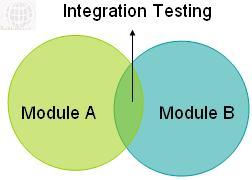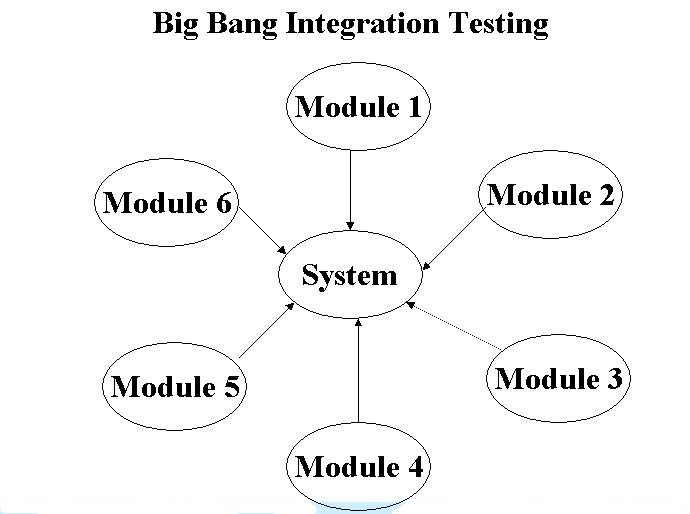- Integration testing tests integration or interfaces between components, interactions to different parts of the system such as an operating system, file system and hardware or interfaces between systems.
- Also after integrating two different components together we do the integration testing. As displayed in the image below when two different modules ‘Module A’ and ‘Module B’ are integrated then the integration testing is done.

- Integration testing is done by a specific integration tester or test team.
- Integration testing follows two approach known as ‘Top Down’ approach and ‘Bottom Up’ approach as shown in the image below:
Below are the integration testing techniques:
1. Big Bang integration testing:
In Big Bang integration testing all components or modules are integrated simultaneously, after which everything is tested as a whole. As per the below image all the modules from ‘Module 1′ to ‘Module 6′ are integrated simultaneously then the testing is carried out.

Advantage: Big Bang testing has the advantage that everything is finished before integration testing starts.
Disadvantage: The major disadvantage is that in general it is time consuming and difficult to trace the cause of failures because of this late integration.
2. Top-down integration testing: Testing takes place from top to bottom, following the control flow or architectural structure (e.g. starting from the GUI or main menu). Components or systems are substituted by stubs. Below is the diagram of ‘Top down Approach’:

Advantages of Top-Down approach:
- The tested product is very consistent because the integration testing is basically performed in an environment that almost similar to that of reality
- Stubs can be written with lesser time because when compared to the drivers then Stubs are simpler to author.
Disadvantages of Top-Down approach:
- Basic functionality is tested at the end of cycle
3. Bottom-up integration testing: Testing takes place from the bottom of the control flow upwards. Components or systems are substituted by drivers. Below is the image of ‘Bottom up approach’:

Advantage of Bottom-Up approach:
- In this approach development and testing can be done together so that the product or application will be efficient and as per the customer specifications.
Disadvantages of Bottom-Up approach:
- We can catch the Key interface defects at the end of cycle
- It is required to create the test drivers for modules at all levels except the top control
Incremental Testing:
Another extreme is that all programmers are integrated one by one, and a test is carried out after each step.
The incremental approach has the advantage that the defects are found early in a smaller assembly when it is relatively easy to detect the cause.
A disadvantage is that it can be time-consuming since stubs and drivers have to be developed and used in the test.
Within incremental integration testing a range of possibilities exist, partly depending on the system architecture.
The incremental approach has the advantage that the defects are found early in a smaller assembly when it is relatively easy to detect the cause.
A disadvantage is that it can be time-consuming since stubs and drivers have to be developed and used in the test.
Within incremental integration testing a range of possibilities exist, partly depending on the system architecture.
Functional incremental: Integration and testing takes place on the basis of the functions and functionalities, as documented in the functional specification.

Hello,
ReplyDeleteThe informative Article onWhat is Integration testing and it's benefits is good. It gives detailed information about it .Thanks for Sharing the information on Integration testing. Software Testing Company